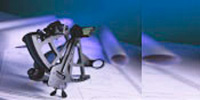Digital watermarking
From Wikipedia, the free encyclopedia
Digital watermarking is the process of embedding information into a digital signal in a way that is difficult to remove. The signal may be audio, pictures or video, for example. If the signal is copied, then the information is also carried in the copy. A signal may carry several different watermarks at the same time.
In visible watermarking, the information is visible in the picture or video. Typically, the information is text or a logo which identifies the owner of the media. The image on the right has a visible watermark. When a television broadcaster adds its logo to the corner of transmitted video, this is also a visible watermark.
In invisible watermarking, information is added as digital data to audio, picture or video, but it cannot be perceived as such (although it may be possible to detect that some amount of information is hidden). The watermark may be intended for widespread use and is thus made easy to retrieve or it may be a form of Steganography, where a party communicates a secret message embedded in the digital signal. In either case, as in visible watermarking, the objective is to attach ownership or other descriptive information to the signal in a way that is difficult to remove. It is also possible to use hidden embedded information as a means of covert communication between individuals.
One application of watermarking is in copyright protection systems, which are intended to prevent or deter unauthorized copying of digital media. In this use a copy device retrieves the watermark from the signal before making a copy; the device makes a decision to copy or not depending on the contents of the watermark. Another application is in source tracing. A watermark is embedded into a digital signal at each point of distribution. If a copy of the work is found later, then the watermark can be retrieved from the copy and the source of the distribution is known. This technique has been reportedly used to detect the source of illegally copied movies.
Annotation of digital photographs with descriptive information is another application of invisible watermarking.
While some file formats for digital media can contain additional information called metadata, digital watermarking is distinct in that the data is carried in the signal itself.
The use of the word of watermarking is derived from the much older notion of placing a visible watermark on paper.
Contents [hide]
1 Applications
2 Watermarking life-cycle phases
3 Classification
3.1 Robustness
3.2 Perceptibility
3.3 Capacity
3.4 Embedding method
4 Evaluation/benchmarking
5 Secure digital camera
5.1 Precursor cameras
6 Reversible data hiding
7 See also
8 External links
9 References
[edit]Applications
Digital Watermarking can be used for a wide range of applications such as:
Copyright protection
Source Tracking (Different recipients get differently watermarked content)
Broadcast Monitoring (Television news often contains watermarked video from international agencies)
Covert Communication
[edit]Watermarking life-cycle phases
General watermark life-cycle phases with embedding-, attacking- and detection/retrieval functions
The information to be embedded is called a digital watermark, although in some contexts the phrase digital watermark means the difference between the watermarked signal and the cover signal. The signal where the watermark is to be embedded is called the host signal. A watermarking system is usually divided into three distinct steps, embedding, attack and detection. In embedding, an algorithm accepts the host and the data to be embedded and produces a watermarked signal.
The watermarked signal is then transmitted or stored, usually transmitted to another person. If this person makes a modification, this is called an attack. While the modification may not be malicious, the term attack arises from copyright protection application, where pirates attempt to remove the digital watermark through modification. There are many possible modifications, for example, lossy compression of the data, cropping an image or video, or intentionally adding noise.
Detection (often called extraction) is an algorithm which is applied to the attacked signal to attempt to extract the watermark from it. If the signal was unmodified during transmission, then the watermark is still present and it can be extracted. In robust watermarking applications, the extraction algorithm should be able to correctly produce the watermark, even if the modifications were strong. In fragile watermarking, the extraction algorithm should fail if any change is made to the signal.
[edit]Classification
A digital watermark is called robust with respect to transformations if the embedded information can reliably be detected from the marked signal even if degraded by any number of transformations. Typical image degradations are JPEG compression, rotation, cropping, additive noise and quantization. For video content temporal modifications and MPEG compression are often added to this list. A watermark is called imperceptible if the cover signal and marked signal are indistinguishable with respect to an appropriate perceptual metric[clarification needed]. In general it is easy to create robust watermarks or imperceptible watermarks, but the creation of robust and imperceptible watermarks has proven to be quite challenging.[1] Robust imperceptible watermarks have been proposed as tool for the protection of digital content, for example as an embedded 'no-copy-allowed' flag in professional video content.[2]
Digital watermarking techniques can be classified in several ways.
[edit]Robustness
A watermark is called fragile if it fails to be detected after the slightest modification. Fragile watermarks are commonly used for tamper detection (integrity proof). Modifications to an original work that are clearly noticeable are commonly not referred to as watermarks, but as generalized barcodes.
A watermark is called semi-fragile if it resists benign transformations but fails detection after malignant transformations. Semi-fragile watermarks are commonly used to detect malignant transformations.
A watermark is called robust if it resists a designated class of transformations. Robust watermarks may be used in copy protection applications to carry copy and access control information.
[edit]Perceptibility
A watermark is called imperceptible if the original cover signal and the marked signal are (close to) perceptually indistinguishable.
A watermark is called perceptible if its presence in the marked signal is noticeable, but non-intrusive.
[edit]Capacity
The length of the embedded message determines two different main classes of watermarking schemes:
The message is conceptually zero-bit long and the system is designed in order to detect the presence or the absence of the watermark in the marked object. This kind of watermarking schemes is usually referred to as Italic zero-bit or Italic presence watermarking schemes. Sometimes, this type of watermarking scheme is called 1-bit watermark, because a 1 denotes the presence (and a 0 the absence) of a watermark.
The message is a n-bit-long stream (, with n = | m | ) or M = {0,1}n and is modulated in the watermark. This kinds of schemes are usually referred to as multiple bit watermarking or non zero-bit watermarking schemes.
[edit]Embedding method
A watermarking method is referred to as spread-spectrum if the marked signal is obtained by an additive modification. Spread-spectrum watermarks are known to be modestly robust, but also to have a low information capacity due to host interference.
A watermarking method is said to be of quantization type if the marked signal is obtained by quantization. Quantization watermarks suffer from low robustness, but have a high information capacity due to rejection of host interference.
A watermarking method is referred to as amplitude modulation if the marked signal is embedded by additive modification which is similar to spread spectrum method but is particularly embedded in the spatial domain.
[edit]Evaluation/benchmarking
The evaluation of digital watermarking schemes can provide detailed information for a watermark designer or for end users. Therefore, different evaluation strategies exist. Often used by a watermark designer is the evaluation of single properties to show, for example, an improvement. End users are mostly not interested in detailed information. They want to know if a given digital watermarking algorithm can be used for their application scenario, and if so, which parameter sets seems to be the best.
[edit]Secure digital camera
A secure digital camera (SDC) is proposed by Mohanty, et al. in 2003 which got published in January 2004 [3] Blythe and Fridrich have also worked on SDC in 2004[4] for a digital camera that would use lossless watermarking to embed a biometric identifier together with a cryptographic hash.[5]
[edit]Precursor cameras
Epson and Kodak have produced cameras with security features such as the Epson PhotoPC 3000Z and the Kodak DC-290. Both cameras added irremovable features to the pictures which distorted the original image, making them unacceptable for some applications such as forensic evidence in court. According to Blythe and Fridrich, "[n]either camera can provide an undisputable proof of the image origin or its author".[4]
[edit]Reversible data hiding
Reversible data hiding is a technique which enables images to be authenticated and then restored to their original form by removing the watermark and replacing the image data which had been overwritten. This would make the images acceptable for legal purposes. The US army is also interested in this technique for authentication of reconnaissance images.[6]
[edit]See also
Audio watermark detection
Copy attack
Watermark (data file)
Watermark detection
Pattern Recognition (novel), a digital watermarking themed sci-fi thriller written by noted cyberpunk author William Gibson
EURion constellation - Used in banknotes
Coded Anti-Piracy - Used to track films
Steganography
[edit]External links
Digital Watermarking Alliance – Furthering the Adoption of Digital Watermarking
Digital Watermarking & Data Hiding research papers at Forensics.nl
Directory of Books, Journals & Conferences on Digital Watermarking and Digital Watermarking Assessment Tools
Information hiding homepage by Fabien Petitcolas
Comparison of watermarking methods
Robust Mesh Watermarking
PhotoWaterMark technology: Holographic approach
Open Platform for testing digital watermarking systems
[edit]References
^ Ingemar J. Cox, Matthew L. Miller, Jeffrey A. Bloom, Jessica Fridrich and Ton Kalker, "Digital Watermarking and Steganography" (Second Edition), Morgan Kaufmann, 2008
^ Copy Protection Technical Working Group (CPTWG)
^ . Saraju P. Mohanty, Nagarajan Ranganathan, and Ravi K. Namballa, VLSI Implementation of Visible Watermarking for a Secure Digital Still Camera Design
^ a b Paul Blythe and Jessica Fridrich, Secure Digital Camera
^ Toshikazu Wada, Fay Huang (2009), Advances in Image and Video Technology, p. 340–341, ISBN 9783540929567
^ Unretouched by human hand, The Economist, December 12th 2002
ECRYPT report: Audio Benchmarking Tools and Steganalysis
ECRYPT report: Watermarking Benchmarking
Jana Dittmann, David Megias, Andreas Lang, Jordi Herrera-Joancomarti; Theoretical framework for a practical evaluation and comparison of audio watermarking schemes in the triangle of robustness, transparency and capacity; In: Transaction on Data Hiding and Multimedia Security I; Springer LNCS 4300; Editor Yun Q. Shi; pp. 1-40; ISBN 978-3-540-49071-5,2006 PDF
M. V. Smirnov. Holographic approach to embedding hidden watermarks in a photographic image //Journal of Optical Technology, Vol. 72, Issue 6, pp. 464-468
Copyright Registration will cost - $ 20
Public offer - read carefully before registration!
1. The Parties of this Public Offer (paid service agreement), hereinafter referred to as the “Agreement” or “Offer”, are, as follows:




